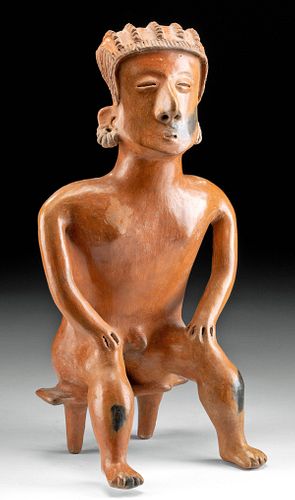Large / Fine Nayarit Pottery Seated Male Figure
Lot 201a
About Seller
Artemis Fine Arts
686 S Taylor Ave, Ste 106
Louisville, CO 80027
United States
Selling antiquities, ancient and ethnographic art online since 1993, Artemis Gallery specializes in Classical Antiquities (Egyptian, Greek, Roman, Near Eastern), Asian, Pre-Columbian, African / Tribal / Oceanographic art. Our extensive inventory includes pottery, stone, metal, wood, glass and textil...Read more
Categories
Estimate:
$4,500 - $6,750
Absentee vs Live bid
Two ways to bid:
- Leave a max absentee bid and the platform will bid on your behalf up to your maximum bid during the live auction.
- Bid live during the auction and your bids will be submitted real-time to the auctioneer.
Bid Increments
| Price | Bid Increment |
|---|---|
| $0 | $25 |
| $300 | $50 |
| $1,000 | $100 |
| $2,000 | $250 |
| $5,000 | $500 |
| $10,000 | $1,000 |
| $20,000 | $2,500 |
| $50,000 | $5,000 |
| $100,000 | $10,000 |
| $200,000 | $20,000 |
About Auction
By Artemis Fine Arts
Mar 24, 2022
Set Reminder
2022-03-24 10:00:00
2022-03-24 10:00:00
America/New_York
Bidsquare
Bidsquare : Exceptional Antiquities Ethnographic Fine Art
https://www.bidsquare.com/auctions/artemis-gallery/exceptional-antiquities-ethnographic-fine-art-9057
Museum-worthy examples of classical antiquities (Egyptian, Greek, Roman, Near Eastern), Viking, Far East / Asian, Pre-Columbian, African / Tribal, Oceanic, Native American, Spanish Colonial, Fossils, Ancient Jewelry, Fine / Visual Arts, so much more! Artemis Fine Arts info@artemisfinearts.com
Museum-worthy examples of classical antiquities (Egyptian, Greek, Roman, Near Eastern), Viking, Far East / Asian, Pre-Columbian, African / Tribal, Oceanic, Native American, Spanish Colonial, Fossils, Ancient Jewelry, Fine / Visual Arts, so much more! Artemis Fine Arts info@artemisfinearts.com
- Lot Description
Pre-Columbian, West Mexico, Nayarit, Ixtlan del Rio, ca. 300 BCE to 300 CE. A marvelous and massive pottery figure of a man depicted nude and sitting atop a 2-legged stool, all enveloped in a vibrant hue of orange. Leaning slightly forward, the impressive figure presents a strong physique with a broad chest, a slender waist, and a delineated phallus. Legs apart, he bends each at the knee for both feet to rest on the ground, as his tubular arms extend outward from his wide, square shoulders placing his hands on his knees. Gazing forth from slit-form eyes, his lifelike visage features a subdued countenance with arched brows, a large, upturned nose, a petite mouth, and a square jaw, all flanked by a pair of rectangular ears adorned by several hoops. A helmet-like headdress with 5 vertical rows of spikes covers the top of his lengthy coiffure, which travels midway down his back, boasting carefully incised striations that outline each and every hair. Size: 8.6" W x 17.8" H (21.8 cm x 45.2 cm)
West Mexican shaft tomb figures like this one derive their names from the central architectural feature that we know of from this culture. These people would build generally rectangular vertical shafts down from the ground level down to narrow horizontal tunnels that led to one or more vaulted or rounded burial chambers. The geomorphology in the area means that these chambers are dug out of tepetate, a type of volcanic tuff material, which give the chambers a rough-edged look. Although the dimensions of the chambers vary considerably - some only large enough to hold a single burial and its offerings, others seem designed to hold entire lineages - the placement of burial goods like this hollow figure was very similar. Grouped with other hollow figures, and alongside clay bowls, and boxes, they were positioned around the body (or bodies), near the skull. Unfortunately, we lack the information we would need to understand what these figures were made for - do they represent everyday people, even individuals? Are they religious? Were they created to mediate between the living and the dead? Whatever their purpose, today they are beautiful artwork and reminders of the mysterious past.
Cf. Metropolitan Museum, 1978.412.7.
Provenance: private Dodge collection, Superior, Colorado, USA; ex-Scottsdale, Arizona, USA collection; ex-Meza collection, California, USA, acquired around 1960
All items legal to buy/sell under U.S. Statute covering cultural patrimony Code 2600, CHAPTER 14, and are guaranteed to be as described or your money back.
A Certificate of Authenticity will accompany all winning bids.
PLEASE NOTE: Due to recent increases of shipments being seized by Australian & German customs (even for items with pre-UNESCO provenance), we will no longer ship most antiquities and ancient Chinese art to Australia & Germany. For categories of items that are acceptable to ship to Australia or Germany, please contact us directly or work with your local customs brokerage firm.
Display stands not described as included/custom in the item description are for photography purposes only and will not be included with the item upon shipping.
#170592Repaired from several pieces with restoration and repainting over break lines. Restoration to back legs of stool. Repainting and modern burnishing throughout. A few expected nicks, commensurate with age and use. Otherwise, excellent.Condition
- Shipping Info
-
All shipping is handled in-house for your convenience. Your invoice from Artemis Gallery will include shipping calculation instructions. If in doubt, please inquire BEFORE bidding for estimated shipping costs for individual items.
-
- Buyer's Premium



 EUR
EUR CAD
CAD AUD
AUD GBP
GBP MXN
MXN HKD
HKD CNY
CNY MYR
MYR SEK
SEK SGD
SGD CHF
CHF THB
THB














